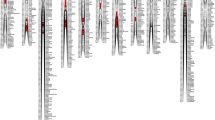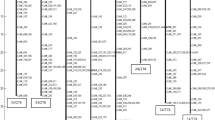Abstract
A considerable array of genomic resources are in place in pearl millet, and marker-aided selection is already in use in the public breeding programme at ICRISAT. This paper describes experiments to extend these publicly available resources to a single nucleotide polymorphism (SNP)-based marker system. A new marker system, single-strand conformational polymorphism (SSCP)-SNP, was developed using annotated rice genomic sequences to initially predict the intron-exon borders in millet expressed sequence tags (ESTs) and then to design primers that would amplify across the introns. An adequate supply of millet ESTs was available for us to identify 299 homologues of single-copy rice genes in which the intron positions could be precisely predicted. PCR primers were then designed to amplify approximately 500-bp genomic fragments containing introns. Analysis of these fragments on SSCP gels revealed considerable polymorphism. A detailed DNA sequence analysis of variation at four of the SSCP-SNP loci over a panel of eight inbred genotypes showed complex patterns of variation, with about one SNP or indel (insertion-deletion) every 59 bp in the introns, but considerably fewer in the exons. About two-thirds of the variation was derived from SNPs and one-third from indels. Most haplotypes were detected by SSCP. As a marker system, SSCP-SNP has lower development costs than simple sequence repeats (SSRs), because much of the work is in silico, and similar deployment costs and through-put potential. The rates of polymorphism were lower but useable, with a mean PIC of 0.49 relative to 0.72 for SSRs in our eight inbred genotype panel screen. The major advantage of the system is in comparative applications. Syntenic information can be used to target SSCP-SNP markers to specific chromosomal regions or, conversely, SSCP-SNP markers can be used to unravel detailed syntenic relationships in specific parts of the genome. Finally, a preliminary analysis showed that the millet SSCP-SNP primers amplified in other cereals with a success rate of about 50%. There is also considerable potential to promote SSCP-SNP to a COS (conserved orthologous set) marker system for application across species by more specifically designing primers to precisely match the model genome sequence.


Similar content being viewed by others
References
Allouis S, Qi X, Lindup S, Gale MD, Devos KM (2001) Construction of a BAC library of pearl millet, Pennisetum glaucum. Theor Appl Genet 102:1200–1205
Bassam BJ, Caetano-Anollés G, Gresshoff PM (1991) Fast and sensitive silver staining of DNA in polyacrylamide gels. Anal Biochem 196:80–83
Bryan GJ, Stephenson P, Collins A, Kirby J, Smith JB, Gale MD (1999). Low levels of DNA sequence variation among adapted genotypes of hexaploid wheat. Theor Appl Genet 99:192–198
Ching A, Caldwell KS, Jung M, Dolan M, Smith OS, Tingey S, Morgante M, Rafalski AJ (2002) SNP frequency, haplotype structure and linkage disequilibrium in elite maize inbred lines. BMC Genet 3:19
Devos KM, Gale MD (2000) Genome relationships: the grass model in current research. Plant Cell 12:637–646
Devos KM, Pittaway TS, Reynolds A, Gale MD (2000) Comparative mapping reveals a complex relationship between the pearl millet genome and those of foxtail millet and rice. Theor Appl Genet 100:190–198
Fulton TM, Van der Hoeven R, Eannetta NT, Tanksley SD (2002) Identification, analysis, and utilization of conserved ortholog set markers for comparative genomics in higher plants. Plant Cell 14:1457–1467
Grieu F, Joseph D, Norman P, Iacopetta B (2003) Development of a rapid genotyping method for single nucleotide polymorphisms and its application in cancer studies. Oncol Rep 11:501–504
Gupta PK, Roy JK, Prasad M (2001) Single nucleotide polymorphisms: a new paradigm for molecular marker technology and DNA polymorphism detection with emphasis on their use in plants. Curr Sci 80:524–535
Hash CT, Raj AGB, Lindup S, Sharma A, Beniwal CR, Folkertsma RT, Mahalakshmi V, Zerbini E, Blummel M (2003) Opportunities for marker-assisted selection (MAS) to improve the feed quality of crop residues in pearl millet and sorghum. Field Crops Res 84:79–88
Liu CJ, Witcombe JR, Pittaway TS, Nash M, Busso CS, Hash CT, Gale MD (1994) An RFLP-based genetic map of pearl millet (Pennisetum glaucum). Theor Appl Genet 89:481–487
Martins-Lopes P, Zhang H, Koebner R (2001) Detection of single nucleotide mutations in wheat using single strand conformation polymorphism gels. Plant Mol Biol Rep 19:159–162
Qi X, Lindup S, Pittaway TS, Allouis S, Gale MD, Devos KM (2001) Development of simple sequence repeat markers from bacterial artificial chromosomes without subcloning. Biotechniques 31:355–362
Qi X, Pittaway TS, Lindup S, Liu H, Waterman E, Padi FK, Hash CT, Zhu J, Gale MD, Devos KM (2004) An integrated genetic map and a new set of simple sequence repeat markers for pearl millet, Pennisetum glaucum. Theor Appl Genet 109:1485–1493
Scholl R, Walker A, Wood BL (2001) Multiplex, fluorescent single-strand conformation polymorphism using stepped polymerase chain reaction primers. J Biomol Technol 12:1–3
Acknowledgements
This manuscript is an output from projects funded by the UK DfID for the benefit of developing countries. The views expressed are not necessarily those of DfID. We also wish to acknowledge Prof. M.K. Reddy’s group at the Plant Molecular Biology Laboratory, International Centre for Genetic Engineering and Biotechnology, New Delhi for developing the ESTs used in this study.
Author information
Authors and Affiliations
Corresponding author
Additional information
Communicated by D.A. Hoisington
Electronic Supplementary Material
Rights and permissions
About this article
Cite this article
Bertin, I., Zhu, J.H. & Gale, M.D. SSCP-SNP in pearl millet—a new marker system for comparative genetics. Theor Appl Genet 110, 1467–1472 (2005). https://doi.org/10.1007/s00122-005-1981-0
Received:
Accepted:
Published:
Issue Date:
DOI: https://doi.org/10.1007/s00122-005-1981-0




